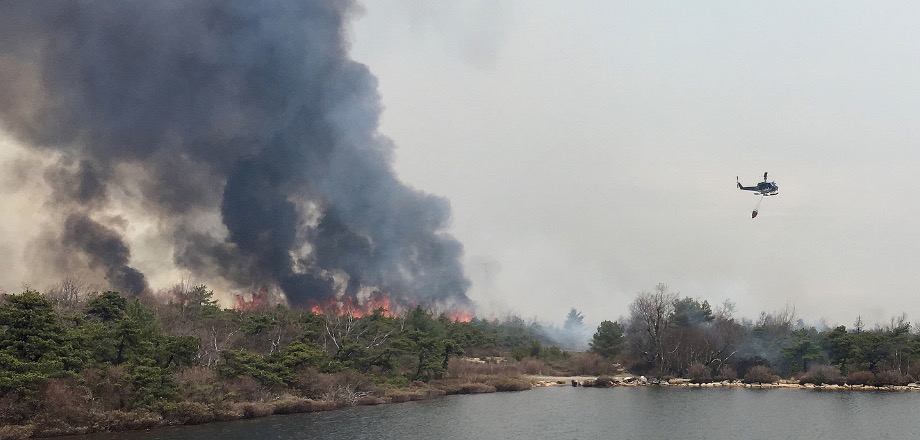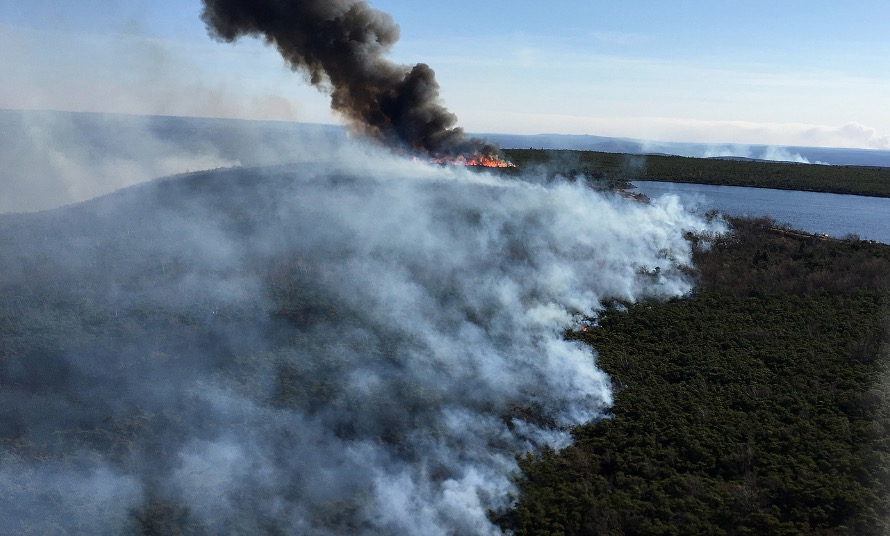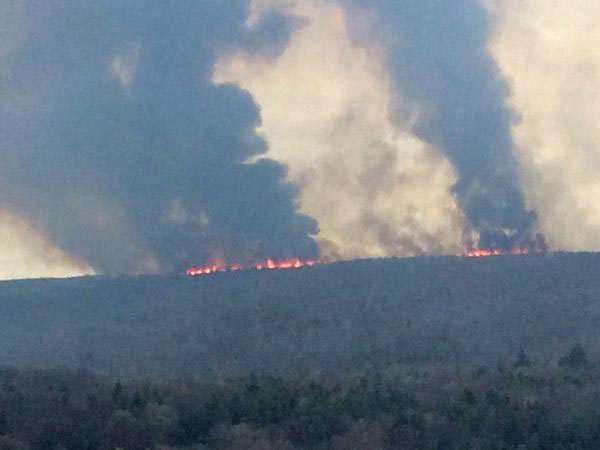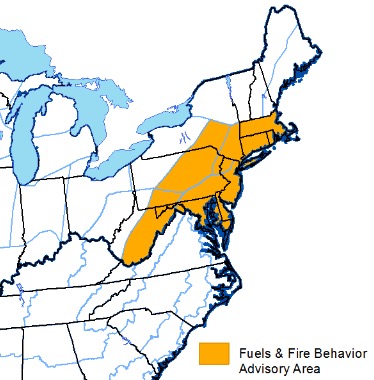Here are some additional video reports about the test of the Unmanned Aircraft System, or drone, that was used April 22 to assist with ignition of a prescribed fire in Homestead National Monument in southeast Nebraska.
Category: Uncategorized
The application of prescribed fire in Brice Prairie
In this video U.S. Fish and Wildlife Service Biologist Bill Kiser gives an excellent description of why and how the agency uses prescribed fire as a management tool in Brice Prairie, north of La Crosse, Wisconsin (map).
Thanks and a tip of the hat go out to Bill.
Lone survivor from Yarnell Hill Fire publishes book
In “My Lost Brothers” Brendan McDonough writes about his journey of becoming a wildland firefighter, and the loss of his 19 “brothers” in 2013 on the fire in Arizona.
Above: Most, but not all, of the members of the Granite Mountain Hotshots at the world’s largest alligator juniper tree in 2013. The crew protected it while fighting the Doce Fire near Prescott, Arizona about two weeks before the tragedy at Yarnell. Photo by Chris Mackenzie.
Last August I interviewed Brendan McDonough, the only firefighter of the 20-person Granite Mountain Hotshot crew that survived the Yarnell Hill Fire south of Prescott, Arizona in June, 2013
He told me that he was working on a book about his life – his background, drug problems, burglary conviction, and becoming a father at age 19. “That’s what I’m saying in the book,” he said. “I’m sharing the stories and the great memories I have of them, and I’m telling my stories about Yarnell – what I saw, how I felt, and what I think happened.”
He said working on the book was therapeutic for him, collaborating with best-selling author Stephan Talty, author of A Captain’s Duty about Richard Phillips, captain of the MV Maersk Alabama that was captured by Somali pirates and later rescued by Navy SEALs.
My Lost Brothers: The Untold Story by the Yarnell Hill Fire’s Lone Survivor, is scheduled for release on May 3, 2016 but may be available before that in bookstores. After reading an advance copy, I found it to be an extremely personal account of Mr. McDonough’s life before becoming a member of the Granite Mountain Hotshots, his experiences while on the crew for three seasons, and how he dealt with the tragedy — the fire that killed 19 of his “brothers” on June 30, 2013.
The 20 men were fighting the Yarnell Hill Fire near Yarnell, Arizona, 90 miles northwest of Phoenix that day. A passing thunderstorm created very strong outflow winds that suddenly changed the direction the fire was spreading, forcing it to make a right turn. The fire raced toward 19 men on the crew, trapping and killing them in a box canyon. Mr. McDonough survived because he was serving as a lookout in a location separate from the others. He also had a close call as the blaze burned toward him, but was rescued by the crew Superintendent on another Hotshot crew who gave him a ride out of danger on a small utility vehicle.
I was hoping that the book would reveal more about WHY the 19 men left the safety of a previously burned area (the “black”) and hiked cross-country through dense unburned brush where they were entrapped by the fire. That is a crucial piece of the puzzle not yet revealed to the public. A piece that could add to the body of knowledge about firefighting that could be a valuable lesson learned — possibly preventing similar fatalities.
But a clue was in our interview eight months ago when he said:
I would never … if my brothers did make mistakes, I would never keep that a secret to put in a book. There’s nothing that is going to be in there that people don’t already know.
And he was true to his word. While he revealed a great deal about his private life, there is little about what happened on June 30, 2013 that has not already come out in the investigations, reports, and the video recordings made by various firefighters that day that included audio of radios used by firefighters. While there are many quotes of radio conversations in the book, most of them appear to have been previously revealed in the recordings. There are no earth-shaking revelations about who made the crucial decisions, or why, that led to the Granite Mountain Hotshots being in the wrong place at the wrong time.
Mr. McDonough wrote in the book:
Continue reading “Lone survivor from Yarnell Hill Fire publishes book”
New York: wildfire in Sam’s Point Preserve
Above: The red and yellow dots represent the locations of heat detected at 1:50 p.m. on April 25, 2016 by a satellite over the wildfire that is burning two miles southeast of Ellenville, New York.
(UPDATED at 11:08 p.m. EDT, April 28, 2016)
The wildfire in Ulster County has been fully contained. Thanks to all state and local first responders: https://t.co/BndjIep41x
— Andrew Cuomo (@NYGovCuomo) April 28, 2016
This will be our last update for this wildfire southeast of Ellenville, NY unless something very unexpected occurs.
****
(UPDATED at 3:25 p.m. EDT April 27, 2016)
Firefighters have mapped the Sam’s Point Fire just southeast of Ellenville, New York and are now calling it 1,574 acres. It was slowed Tuesday by damp weather after being very active on Monday. Today will be sunny and drier with the relative humidity dropping to 29 percent by late afternoon. That and the 6 to 8 mph winds out of the west combined with a Haines Index of 5 could result in more fire movement this evening.
Approximately 226 personnel are assigned to the fire.
The fire is being managed by a Type 2 Incident Management Team, Kevin Slade (NYS DEC DFP) and Jim Prunoske (NYS DHSES IMT).
Video from 4/25/16 of a fly over of the Sam’s Point Preserve brushfire pic.twitter.com/Zrj63kWELk
— NYS DHSES (@NYSDHSES) April 27, 2016


****
(UPDATED at 8:10 p.m. EDT April 26, 2016)
As of Tuesday morning the Sam’s Point Fire had burned 2,000 acres in Ulster County 21 miles west of Poughkeepsie. The fire was very active Monday afternoon with 35 to 40-foot flames rapidly chewing up an additional 1,200 acres. The fire is on land managed by Minnewaska State Park.
According to News12, fog and rain today, Tuesday, are helping firefighters.
The Ellenville, New York Fire Department apparently does not often have to deal with large vegetation fires like the one currently burning in Sam’s Point Preserve. According to the TimesHerald-Record they are asking for donations.
Anyone who has a chainsaw they do not use or need and would like to donate it, is asked to bring it to the Pioneer Fire Company, 73 Center St., in Ellenville on Tuesday. Also, the Rolling V Bus Company on Canal Street in Ellenville is doing a “Stuff the Bus” drive for the firefighters from 9 a.m. to noon on Tuesday. Items such as water, socks, toilet paper and work gloves are needed.
It is depressing that a fire department has to beg for these items.
Fog & rain helps fight 800+ acre #wildfire in #Ulster County. More later on #News12 & https://t.co/WLk1PZM7Hr pic.twitter.com/vdp953KHtW
— John Goff (@JohnGoff_News12) April 26, 2016
Below, photos from Sunday and Monday:
Viewing the Ulster County brushfire in Sam’s Point Preserve from the air pic.twitter.com/cI8sVKn3jk
— NYS DHSES (@NYSDHSES) April 25, 2016
Busy day in Ulster Cty. Proud to work with such professional NYS and Local Public Safety providers. Keeping NYS Safe pic.twitter.com/wWU0PBHLmC
— Kevin Wisely (@KevinWisely1) April 24, 2016
****
(Originally published at 6:36 p.m. EDT April 25, 2016)
A wildfire that has been burning since April 23 in Sam’s Point Preserve just southeast of Ellenville, New York has grown to about 800 acres. The fire in Ulster County 21 miles west of Poughkeepsie is being fought by about 110 personnel from thirteen local fire departments, the NY Department of Environmental Conservation, and NY State Parks. Two helicopters operated by the State Police have been dropping water on the blaze, 250 gallons at a time.
According to the Governor’s office, the fire is being managed by the State Incident Management Team, which integrated into the State Forest Rangers, and an a Structure Protection Group.

New York does is not often presented with the challenge of suppressing large wildfires. The state apparently has a unique system that, if one is to believe literally the press releases, the Governor either chooses to or is required to become involved in making management decisions about staffing the incidents. Or perhaps the Governor just likes to have his name associated with mitigating an emergency.
Today I directed state emergency personnel to a wildfire in Ulster County that has consumed nearly 300 acres: https://t.co/IKKItkym7I
— Andrew Cuomo (@NYGovCuomo) April 24, 2016
Today I deployed an additional 70 state personnel to combat the wildfire in Ulster County: https://t.co/gEjXfVtat0
— Andrew Cuomo (@NYGovCuomo) April 25, 2016
Last year in early May the Roosa Gap Fire in the same general area, about 5 miles south of Ellenville, burned over 2,400 acres. That was the first time in recent memory that an air tanker had been used in the state.
Fuels and fire behavior advisory
A Predictive Services unit wrote this Fuels and Fire Behavior Advisory — it’s not clear which one, regional or national. It was distributed by the National Interagency Coordination Center. Our view is that if you are distributing an important directive and calling for action, the person, or at least the unit, that analyzed the data and developed the recommendations should be identified. This is not the place for anonymity.
Fuels and Fire Behavior Advisory
Southeastern Halves of New England/Mid-Atlantic States
April 24, 2016
Subject: Fuel conditions/elevated significant fire potential across the southeastern halves of New England and Mid-Atlantic states.
Discussion: Short to medium range drought developed across the southeastern halves of New England and the Mid-Atlantic States through the second half of March into April 2016. Calculated 1000 hour fuel moisture levels at many RAWS across these areas were below 17% and 100 hour fuels below 10%. NFDRS Energy Release Components and Burning Indices were well above the 90th percentile as well. These conditions have led to periods of above normal fire potential across portions of the Northeast and Mid-Atlantic late March through April of 2016 during dry and windy periods.
Fire behavior reports from fires occurring near and within the areas of concern through mid-April indicated rapid rates of spread. Abnormal nighttime fire activity was also reported on some of the fires creating suppression problems and increased fire size. While the main driver of fire occurrence and behavior was fine fuels, 100 and 1000 hour fuels were also receptive to ignition and some consumption, leading to more intense and persistent fires. Until rainfall increases over these areas, elevated fire potential and problematic fire behavior is likely during any dry and windy periods into May 2016.
Difference from normal conditions: Calculated NFDRS indices and fuel moistures from various RAWS across the areas of concern were at or approaching extreme levels or the 97th percentile. Prolonged periods of minimum RH levels were observed through mid-April significantly drying out fuels.
Concerns to Firefighters and the Public:
- Anticipate any ignition in flashy fine fuels to burn readily and move rapidly during periods of dry and windy weather conditions.
- Anticipate heavier fuel involvement where 1000 and 100 hour fuel moistures have dropped to critical levels.
Mitigation Measures:
- Make certain firefighters have good anchor points and keep one foot in the black.
- Ensure LCES is in place on every fire before engaging. Lookouts should have a good understanding of the effects of weather changes and topography on fire behavior.
- Become familiar with local fuel conditions and current fire danger indices, and their implications for fire behavior.
Area of Concern: Southeastern Halves of New England/Mid-Atlantic States.
Jerry Williams: can-do, to make-do, to tragedy
This video was posted by Colorado Fire Camp on their Facebook page. It shows less than three minutes of a talk by Jerry Williams, who became Director of Fire and Aviation for the U.S. Forest Service. It was 1995, a year after 14 firefighters were killed on the South Canyon Fire in Colorado.
Here is a partial transcript of Jerry Williams’ talk:
…It’s a proud outfit. It’s a can-do outfit… It’s a real short step between can-do, and make-do, and from make do to tragedy.
If the forests we work in start to come undone and get too hot, we’ll go contain/confine and we’ll make-do. Our budgets drop, we’ll go with three per engine instead of five and we’ll make-do.
We come up short Division [Supervisors], we’ll rob a hotshot crew of a Division and put him on the division, and we’ll make-do.
We need to quit thinking about making do.
Maybe we need to quit thinking about just doing the job, and begin thinking about doing the job right.
I used to tell my firefighters, “If we can’t do it safely, we won’t do it at all.” Mr. Williams said it much more eloquently.



